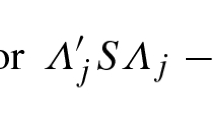Abstract
A universe of infinitely many quantitative variables is considered, from which a sample ofn variables is arbitrarily selected. Only linear least-squares regressions are considered, based on an infinitely large population of individuals or respondents. In the sample of variables, the predicted value of a variablex from the remainingn − 1 variables is called the partial image ofx, and the error of prediction is called the partial anti-image ofx. The predicted value ofx from the entire universe, or the limit of its partial images asn → ∞, is called the total image ofx, and the corresponding error is called the total anti-image. Images and anti-images can be used to explain “why” any two variablesx j andx k are correlated with each other, or to reveal the structure of the intercorrelations of the sample and of the universe. It is demonstrated that image theory is related to common-factor theory but has greater generality than common-factor theory, being able to deal with structures other than those describable in a Spearman-Thurstone factor space. A universal computing procedure is suggested, based upon the inverse of the correlation matrix.
Similar content being viewed by others
References
Guttman, Louis. A note on the derivation of formulae for multiple and partial correlation.Ann. math. Statist., 1938,9, 305–308.
Guttman, Louis. Multiple rectilinear prediction and the resolution into components.Psychometrika, 1940,5, 75–99.
Guttman, Louis, and Cohen, Jozef. Multiple rectilinear prediction and the resolution into components: II.Psychometrika, 1943,8, 169–183.
Guttman, Louis. Review of Thurstone'sMultiple-factor analysis. J. Amer. statist. Ass., 1947,42, 651–656.
Guttman, Louis. The Israel alpha technique for scale analysis: a preliminary statement (stenciled). The Israel Institute of Applied Social Research, Jerusalem, Israel, 1951.
Guttman, Louis. The theory of nodular structures. (In preparation)
Guttman, Louis. A new approach to factor analysis: The Radex. In Paul F. Lazarsfeld, Mathematical thinking in the social sciences. New York: Columbia Univ. Press, 1953.
Guttman, Louis. The matrices of least-squares image analysis. (In preparation)
Guttman, Louis. The existence of total least-squares images and anti-images (In preparation)
Guttman, Louis. A reanalysis of factor analysis. (In preparation)
Jackson, Dunham. The trigonometry of correlation.Amer. math. Monthly, 1924,31, 275–280.
Thurstone, L. L. Multiple-factor analysis. Chicago: Univ. Chicago Press, 1947.
Author information
Authors and Affiliations
Additional information
This paper introduces one of three new structural theories, each of which generalizes common-factor analysis in a different direction.Nodular theory extends common-factor analysis to qualitative data and to data with curvilinear regressions (6).Order-factor theory introduces the notions oforder among the observed variables and ofseparable factors (7). The presentimage theory is relevant also to the other two.
Attention may be called to empirical results published since this paper was written: Louis Guttman, “Two new approaches to factor analysis,” Annual Technical Report on contract Nonr—731(00). The present research was aided by an uncommitted grant-in-aid from the Ford Foundation.
Rights and permissions
About this article
Cite this article
Guttman, L. Image theory for the structure of quantitative variates. Psychometrika 18, 277–296 (1953). https://doi.org/10.1007/BF02289264
Issue Date:
DOI: https://doi.org/10.1007/BF02289264




